Combining Chemical Composition Data and Numerical Modelling for the Assessment of Air Quality in a Mediterranean Port City
Abstract
1. Introduction
Scope and Content of the Paper
2. Site Description and Techniques for Data Analyses
2.1. Experimental Site and General Methodology
2.2. Gravimetric and Chemical Analysis
2.3. Statistical Treatment of Data: Principal Component Analysis and Linear Discriminant Analysis
2.4. Numerical Modelling
2.4.1. Ship Emissions
2.4.2. Models Description and Set-Up
3. Results and Discussion
3.1. Overview on PM2.5 Composition in the Investigated Area
3.2. Principal Component Analysis
3.3. Linear Discriminant Analysis
3.4. Mass Closure Analysis
3.5. Modelling Results
3.5.1. Pollutant Concentration Levels in the Study Area
3.5.2. Ship Emissions Impact
- prevailing winds from northern sectors (SIM_port hereinafter);
- prevailing wind from southern sectors (SIM_urb-ind hereinafter);
- finally, SIM_tot refers to the period comprising all the days considered in the previous two simulations.
4. Summary and Conclusions
Author Contributions
Funding
Institutional Review Board Statement
Informed Consent Statement
Data Availability Statement
Acknowledgments
Conflicts of Interest
References
- Mangia, C.; Ielpo, P.; Cesari, R.; Facchini, C. Crisi climatica e inquinamento atmosferico. Ithaca Viaggio Nella Scienza 2020, 15, 1–11. [Google Scholar]
- Von Schneidemesser, E.; Monks, P.S.; Allan, J.D.; Bruhwiler, L.; Forster, P.; Fowler, D.; Lauer, A. Chemistry and the linkages between air quality and climate change. Chem. Rev. 2015, 115, 3856–3897. [Google Scholar] [CrossRef]
- Leibensperger, E.M.; Mickley, L.J.; Jacob, D.J.; Kumar, N.; Rind, D. Climatic effects of 1950-2050 changes in US anthropogenic aerosols-Part 1: Aerosol trends and radiative forcing. Atmos. Chem. Phys. 2012, 12, 3333–3348. [Google Scholar] [CrossRef]
- Leibensperger, E.M.; Mickley, L.J.; Jacob, D.J.; Kumar, N.; Rind, D. Climatic effects of 1950-2050 changes in US anthropogenic aerosols-Part 2: Climate response. Atmos. Chem. Phys. 2012, 12, 3349–3362. [Google Scholar] [CrossRef]
- Karanasiou, A.; Querol, X.; Alastuey, A.; Perez, N.; Pey, J.; Perrino, C.; Berti, G.; Gandini, M.; Poluzzi, V.; the MED-PARTICLES Study Group; et al. Particulate matter and gaseous pollutants in the Mediterranean Basin: Results from the MED-PARTICLES project. Sci. Tot. Environ. 2014, 488–490, 297–315. [Google Scholar] [CrossRef] [PubMed]
- Gaisbauer, S.; Wankmüller, R.; Matthews, B.; Mareckova, K.; Schindlbacher, S.; Tista, M.; Ullrich, B. Emissions for 2017. In Transboundary Particulate Matter, Photo-Oxidants, Acidifying and Eutrophying Components; EMEP Status Report 1/2019; The Norwegian Meteorological Institute: Oslo, Norway, 2017; pp. 43–64. Available online: https://emep.int/publ/reports/2019/EMEP_Status_Report_1_2019.pdf (accessed on 1 December 2020).
- Eyring, V.; Isaksen, I.S.A.; Berntsen, T.; Collins, W.J.; Corbett, J.J.; Endresen, O.; Grainger, R.G.; Moldanova, J.; Schlager, H.; Stevenson, D.S. Transport impacts on atmosphere and climate: Shipping. Atmos. Environ. 2010, 44, 4735–4771. [Google Scholar] [CrossRef]
- Viana, M.; Hammingh, P.; Colette, A.; Querol, X.; Degraeuwe, B.; de Vlieger, I.; van Aardenne, J. Impact of maritime transport emissions on coastal air quality in Europe. Atmos. Environ. 2014, 90, 96–105. [Google Scholar] [CrossRef]
- Monteiro, A.; Russo, M.; Gama, C.; Borrego, C. How important are maritime emissions for the air quality: At European and national scale. Environ. Pollut. 2018, 242, 565–575. [Google Scholar] [CrossRef]
- Jonson, J.; Gauss, M.; Schulz, M.; Nyíri, A. Emissions from international shipping. In Transboundary Particulate Matter, Photo-oxidants, Acidifying and Eutrophying Components; EMEP Status Report 1/2018; The Norwegian Meteorological Institute: Oslo, Norway, 2018; pp. 83–98. Available online: https://emep.int/publ/reports/2018/EMEP_Status_Report_1_2018.pdf (accessed on 1 December 2020).
- Jonson, J.; Gauss, M.; Schulz, M.; Jalkanen, J.-P.; Fagerli, H. Effects of global ship emissions on European air pollution levels. Atmos. Chem. Phys. 2020, 20, 11399–11422. [Google Scholar] [CrossRef]
- Marmer, E.; Langmann, B. Impact of ship emissions on the Mediterranean summertime pollution and climate: A regional model study. Atmos. Environ. 2005, 39, 4659–4669. [Google Scholar] [CrossRef]
- Tagaris, E.; Stergiou, I.; Sotiropoulou, R.-E.P. Impact of shipping emissions on ozone levels over Europe: Assessing the relative importance of the Standard Nomenclature for Air Pollution (SNAP) categories. Environ. Sci. Pollut. Res. 2017, 24, 14903–14909. [Google Scholar] [CrossRef] [PubMed]
- Eyring, V.; Stevenson, D.S.; Lauer, A.; Dentener, F.J.; Butler, T.; Collins, W.J.; Ellingsen, K.; Gauss, M.; Hauglustaine, D.A.; Isaksen, I.S.A.; et al. Multi-model simulations of the impact of international shipping on Atmospheric Chemistry and Climate in 2000 and 2030. Atmos. Chem. Phys. 2007, 7, 757–780. [Google Scholar] [CrossRef]
- Sofiev, M.; Winebrake, J.J.; Johansson, L.; Carr, E.W.; Prank, M.; Soares, J.; Vira, J.; Kouznetsov, R.; Jalkanen, J.-P.; Corbett, J.J. Cleaner fuels for ships provide public health benefits with climate tradeoffs. Nature 2018, 9, 406. [Google Scholar] [CrossRef] [PubMed]
- Schinas, O.; Stefanakos, C.N. Cost assessment of environmental regulation and options for marine operators. Transp. Res. Part C Emerg. Technol. 2012, 25, 81–99. [Google Scholar] [CrossRef]
- Yang, Z.L.; Zhang, D.; Caglayan, O.; Jenkinson, I.D.; Bonsall, S.; Wang, J.; Huang, M.; Yan, X.P. Selection of techniques for reducing shipping NOx and SOx emissions. Transp. Res. D Transp. Environ. 2012, 17, 478–486. [Google Scholar] [CrossRef]
- Sorte, S.; Rodrigues, V.; Borrego, C.; Monteiro, A. Impact of harbour activities on local air quality: A review. Environ. Pollut. 2020, 257, 113542. [Google Scholar] [CrossRef]
- Schembari, C.; Cavalli, F.; Cuccia, E.; Hjorth, J.; Calzolai, G.; Perez, N.; Pey, J.; Prati, P.; Raes, F. Impact of a European directive on ship emissions on air quality in Mediterranean harbours. Atmos. Environ. 2012, 61, 661–669. [Google Scholar] [CrossRef]
- Buccolieri, R.; Cesari, R.; Dinoi, A.; Maurizi, A.; Tampieri, F.; Di Sabatino, S. Impact of ship emissions on local air quality in a Mediterranean city’s harbour after the European Sulphur directive. Int. J. Environ. Pollut. 2016, 29, 30–42. [Google Scholar] [CrossRef]
- Cesari, D.; Genga, A.; Ielpo, P.; Siciliano, M.; Mascolo, G.; Grasso, F.M.; Contini, D. Source apportionment of PM2.5 in the harbour-industrial area of Brindisi (Italy): Identification and estimation of the contribution of in-port ship emissions. Sci. Tot. Environ. 2014, 497, 392–400. [Google Scholar] [CrossRef]
- Donateo, A.; Gregoris, E.; Gambaro, A.; Merico, E.; Giua, R.; Nocioni, A.; Contini, D. Contribution of harbour activities and ship traffic to PM2.5, particle number concentrations and PAHs in a port city of the Mediterranean Sea (Italy). Environ. Sci. Pollut. Res. 2015, 21, 9415–9429. [Google Scholar] [CrossRef]
- Belis, C.A.; Karagulian, F.; Larsen, B.R.; Hopke, P.K. Critical review and meta-analysis of ambient particulate matter source apportionment using receptor models in Europe. Atmos. Environ. 2013, 69, 94–108. [Google Scholar] [CrossRef]
- Belis, C.A.; Pernigotti, D.; Karagulian, F.; Pirovano, G.; Larsen, B.R.; Gerboles, M.; Hopke, P.K. A new methodology to assess the performance and uncertainty of source apportionment models in intercomparison exercises. Atmos. Environ. 2015, 119, 35–44. [Google Scholar] [CrossRef]
- Seigneur, C. Current status of air quality models for particulate matter. J. Air Waste Manag. Assoc. 2001, 51, 1508–1521. [Google Scholar] [CrossRef] [PubMed]
- Pirovano, G.; Balzarini, A.; Bessagnet, B.; Emery, C.; Kallos, G.; Meleux, F.; Mitsakou, C.; Nopmongcol, U.; Riva, G.M.; Yarwood, G. Investigating impacts of chemistry and transport model formulation on model performance at European scale. Atmos. Environ. 2012, 53, 93–109. [Google Scholar] [CrossRef]
- Marmer, E.; Dentener, F.; Aardenne, J.; Cavalli, F.; Vignati, E.; Velchev, K.; Hjorth, J.; Boersma, F.; Raes, F. What can we learn about ship emission inventories from measurements of air pollutants over the Mediterranean Sea. Atmos. Chem. Phys. 2009, 9, 6815–6831. [Google Scholar] [CrossRef]
- Zhang, Y.; Vijayaraghavan, K.; Seigneur, C. Evaluation of three probing techniques in a three-dimensional air quality model. J. Geophys. Res. 2005, 110, D02305. [Google Scholar] [CrossRef]
- Bove, M.C.; Brotto, P.; Cassola, F.; Cuccia, E.; Massabò, D.; Mazzinoa, A.; Piazzalunga, A.; Prati, P. An integrated PM2.5 source apportionment study: Positive matrix factorisation vs. the chemical transport model CAMx. Atmos. Environ. 2014, 94, 274–286. [Google Scholar] [CrossRef]
- Putaud, J.P.; Van Dingenen, R.; Alastuey, A.; Bauer, H.; Birmili, W.; Cyrys, J.; Flentje, H. A European aerosol phenomenology-3: Physical and chemical characteristics of particulate matter from 60 rural, urban, and kerbside sites across Europe. Atmos. Environ. 2010, 44, 1308–1320. [Google Scholar] [CrossRef]
- Mircea, M.; D’Isidoro, M.; Maurizi, A.; Vitali, L.; Conforti, F.; Zanini, G.; Tampieri, F. A comprehensive performance evaluation of the air quality model BOLCHEM to reproduce the ozone concentrations over Italy. Atmos. Environ. 2008, 42, 1169–1185. [Google Scholar] [CrossRef]
- Cesari, R.; Landi, T.C.; D’Isidoro, M.; Mircea, M.; Russo, F.; Malguzzi, P.; Tampieri, F.; Maurizi, A. The On-Line Integrated Mesoscale Chemistry Model BOLCHEM. Atmosphere 2021, 12, 192. [Google Scholar] [CrossRef]
- CERC ADMS-Urban User Guide. 2020. Available online: http://cerc.co.uk/environmental-software/assets/data/doc_userguides/CERC_ADMS-Urban5.0_User_Guide.pdf (accessed on 9 November 2020).
- Birch, M.E.; Cary, R.A. Elemental carbon-based method for monitoring occupational exposures to particulate diesel exhaust. Aerosol. Sci. Technol. 1996, 25, 221–241. [Google Scholar] [CrossRef]
- Cassinelli, M.E.; O’Connor, P.F. (Eds.) NIOSH: Method 5040. In NIOSH: Manual of Analytical Methods (NMAM), 4th ed.; 1998; Suppl. 2, Supplement to DHHS (NIOSH) Publication No. 94-113. Available online: https://www.cdc.gov/niosh/docs/2014-151/pdfs/methods/5040.pdf (accessed on 1 March 2021).
- Scerri, M.M.; Genga, A.; Iacobellis, S.; Delmaire, G.; Give, A.; Siciliano, M.; Siciliano, T.; Weinbruch, S. Investigating the plausibility of a PMF source apportionment solution derived using a small dataset: A case study from a receptor in a rural site in Apulia—South East Italy. Chemosphere 2019, 236, 124376. [Google Scholar] [CrossRef] [PubMed]
- Siciliano, T.; Siciliano, M.; Malitesta, C.; Proto, A.; Cucciniello, R.; Give, A.; Iacobellis, S.; Genga, A. Carbonaceous PM10 and PM2.5 and secondary organic aerosol in a coastal rural site near Brindisi (Southern Italy). Environ. Sci. Pollut. Res. 2018, 25, 23929–23945. [Google Scholar] [CrossRef] [PubMed]
- Thurston, G.D.; Spengler, J.D. A quantitative assessment of source contributions to inhalable particulate matter pollution in metropolitan Boston. Atmos. Environ. 1985, 19, 9–25. [Google Scholar] [CrossRef]
- Brereton, R.G. Applied Chemometrics for Scientists; John Wiley & Sons Ltd.: Hoboken, NJ, USA, 2007. [Google Scholar]
- Belis, C.A.; Larsen, B.R.; Amato, F.; Haddad, I.E.; Favez, O.; Harrison, R.M.; Hopke, P.K.; Nava, S.; Paatero, P.; Prévôt, A.; et al. European Guide on Air Pollution Source Apportionment with Receptor Models; Report EUR 26080 EN; Publications Office of the European Union: Luxembourg, 2014. [Google Scholar]
- Rencher, A.C. Methods of Multivariate Analysis; John Wiley & Sons Ltd.: Hoboken, NJ, USA, 2002. [Google Scholar]
- Ielpo, P.; Leardi, R.; Pappagallo, G.; Uricchio, V.F. Tools based on multivariate statistical analysis for classification of soil and groundwater in Apulian agricultural sites. Environ. Sci. Pollut. Res. 2016, 24, 13967–13978. [Google Scholar] [CrossRef] [PubMed]
- EEA/EMEP Air pollutant Emission Inventory Guidebook, Technical Report No 12/2013. Available online: https://www.eea.europa.eu/publications/emep-eea-guidebook-2013/at_download/file (accessed on 9 November 2020).
- Buzzi, A.; Fantini, M.; Malaguzzi, P.; Nerozzi, P. Validation of a limited area model in cases of Mediterranean cyclogenesis: Surface fields and precipitation scores. Meteorol. Atmos. Phys. 1994, 53, 37153. [Google Scholar] [CrossRef]
- Carter, W.A. detailed mechanism for the gas phase atmospheric reactions of organic compounds. Atmos. Environ. 1990, 27A, 481518. [Google Scholar] [CrossRef]
- Silibello, C.; Calori, G.; Brusasca, G.; Giudici, A.; Angelino, E.; Fossati, G.; Peroni, E.; Buganza, E. Modelling of PM10 concentrations over Milano urban area using two aerosol modules. Environ. Model. Softw. 2008, 23, 333343. [Google Scholar] [CrossRef]
- Binkowski, F.S.; Roselle, S.J. Models-3 Community Multiscale Air Quality (CMAQ) model aerosol component 1. Model description. J. Geophys. Res. 2003, 108 D6, 4183. [Google Scholar] [CrossRef]
- Nenes, A.; Pandis, S.N.; Pilinis, C. ISORROPIA: A new thermodynamic equilibrium model for multiphase multicomponent inorganic aerosols. Aquat. Geochem. 1998, 4, 123152. [Google Scholar] [CrossRef]
- Schell, B.; Ackermann, I.J.; Hass, H.; Binkowski, F.S.; Abel, A. Modeling the formation of secondary organic aerosol within a comprehensive air quality modeling system. J. Geophys. Res. 2001, 106, 2827528293. [Google Scholar] [CrossRef]
- Cesari, R.; D’Isidoro, M.; Maurizi, A.; Mircea, M.; Monti, F.; Pizzigalli, C. Modelling dispersion of smoke from wildfires in a Mediterranean area. Int. J. Environ. Pollut. 2014, 55, 219–229. [Google Scholar] [CrossRef]
- Cesari, R.; Landi, T.; Maurizi, A. The coupled chemistry-meteorology model BOLCHEM: An application to air pollution in the Po Valley (Italy) hot spot. Int. J. Environ. Pollut. 2019, 65, 1–24. [Google Scholar] [CrossRef]
- Colette, A.; Granier, C.; Hodnebrog, O.; Jakobs, H.; Maurizi, A.; Nyiri, A.; Bessagnet, B.; D’Angiola, A.; D’Isidoro, M.; Gauss, M.; et al. Air quality trends in Europe over the past decade: A first multi- model assessment. Atmos. Chem. Phys. 2011, 11, 11657–11678. [Google Scholar] [CrossRef]
- Kuenen, J.J.P.; Visschedijk, A.J.H.; Jozwicka, M.; Denier van der Gon, H.A.C. TNO-MACC_II emission inventory; a multi-year (2003–2009) consistent high-resolution European emission inventory for air quality modeling. Atmos. Chem. Phys. 2014, 14, 10963–10976. [Google Scholar] [CrossRef]
- Symeonidis, P.; Poupkou, A.; Gkantou, A.; Melas, D.; Yay, O.D.; Pouspourika, E.; Balis, D. Development of a computational system for estimating biogenic NMVOCs emissions based on GIS technology. Atmos. Environ. 2008, 42, 1777–1789. [Google Scholar] [CrossRef]
- Venkatram, A.; Karamchandani, P.; Pai, P.; Goldstein, R. The Development and Application of a Simplified Ozone Modelling System. Atmos. Environ. 1994, 28, 3665–3678. [Google Scholar] [CrossRef]
- Cesari, R.; Buccolieri, R.; Dinoi, A.; Maurizi, A.; Landi, T.C.; Di Sabatino, S. Influence of Ship Emissions on Ozone Concentration in a Mediterranean Area: A Modelling Approach. In Air Pollution Modeling and Its Application XXV; Springer Proceedings in Complexity; Mensink, C., Kallos, G., Eds.; Springer: Cham, Switzerland, 2018. [Google Scholar]
- Contini, D.; Cesari, D.; Genga, A.; Siciliano, M.; Ielpo, P.; Guascito, M.R.; Conte, M. Source apportionment of size-segregated atmospheric particles based on the major water-soluble components in Lecce (Italy). Sci. Tot. Environ. 2014, 472, 248–261. [Google Scholar] [CrossRef]
- Cesari, D.; Contini, D.; Genga, A.; Siciliano, M.; Elefante, C.; Baglivi, F.; Daniele, L. Analysis of raw soils and their re-suspended PM10 fractions: Characterisation of source profiles and enrichment factors. Appl. Geochem. 2012, 27, 1238–1246. [Google Scholar] [CrossRef]
- Genga, A.; Baglivi, F.; Siciliano, M.; Siciliano, T.; Tepore, M.; Micocci, G.; Tortorella, C.; Aiello, D. SEM-EDS investigation on PM10 data collected in central Italy: Principal Component Analysis and Hierarchical Cluster Analysis. Chem. Centr. J. 2012, 6, S3. [Google Scholar] [CrossRef] [PubMed]
- Wedepohl, K.H. The composition of the continental crust. Geochim. Cosmochim. Acta 1995, 59, 1217–1232. [Google Scholar] [CrossRef]
- Genga, A.; Ielpo, P.; Siciliano, T.; Siciliano, M. Carbonaceous particles and aerosol mass closure in PM2.5 collected in a port city. Atmos. Res. 2017, 183, 245–254. [Google Scholar] [CrossRef]
- Turpin, B.J.; Huntzicker, J.J.; Hering, S.V. Investigation of organic aerosol sampling artifacts in the Los Angeles basin. Atmos. Environ. 1994, 28, 3061–3071. [Google Scholar] [CrossRef]
- Jiang, J.; Aksoyoglu, S.; Ciarelli, G.; Baltensperger, U.; Prévôt, A.S.H. Changes in ozone and PM2.5 in Europe during the period of 1990–2030: Role of reductions in land and ship emissions. Sci. Total Environ. 2020, 741, 140467. [Google Scholar] [CrossRef]
- Maurizi, A.; Mircea, M.; D’Isidoro, M.; Vitali, L.; Monforti, F.; Zanini, G.; Tampieri, F. Ozone modeling over Italy: A sensitivity analysis to precursors using BOLCHEM air quality model. In Air Pollution Modelling and Its Application XIX; Springer: Dordrecht, The Netherland, 2008. [Google Scholar]
- Merico, E.; Donateo, A.; Gambaro, A.; Cesari, D.; Gregoris, E.; Barbaro, E.; Dinoi, A.; Giovanelli, G.; Masieri, S.; Contini, D. Influence of in-port ships emissions to gaseous atmospheric pollutants and to particulate matter of different sizes in a Mediterranean harbour in Italy. Atmos. Environ. 2016, 139, 1–10. [Google Scholar] [CrossRef]
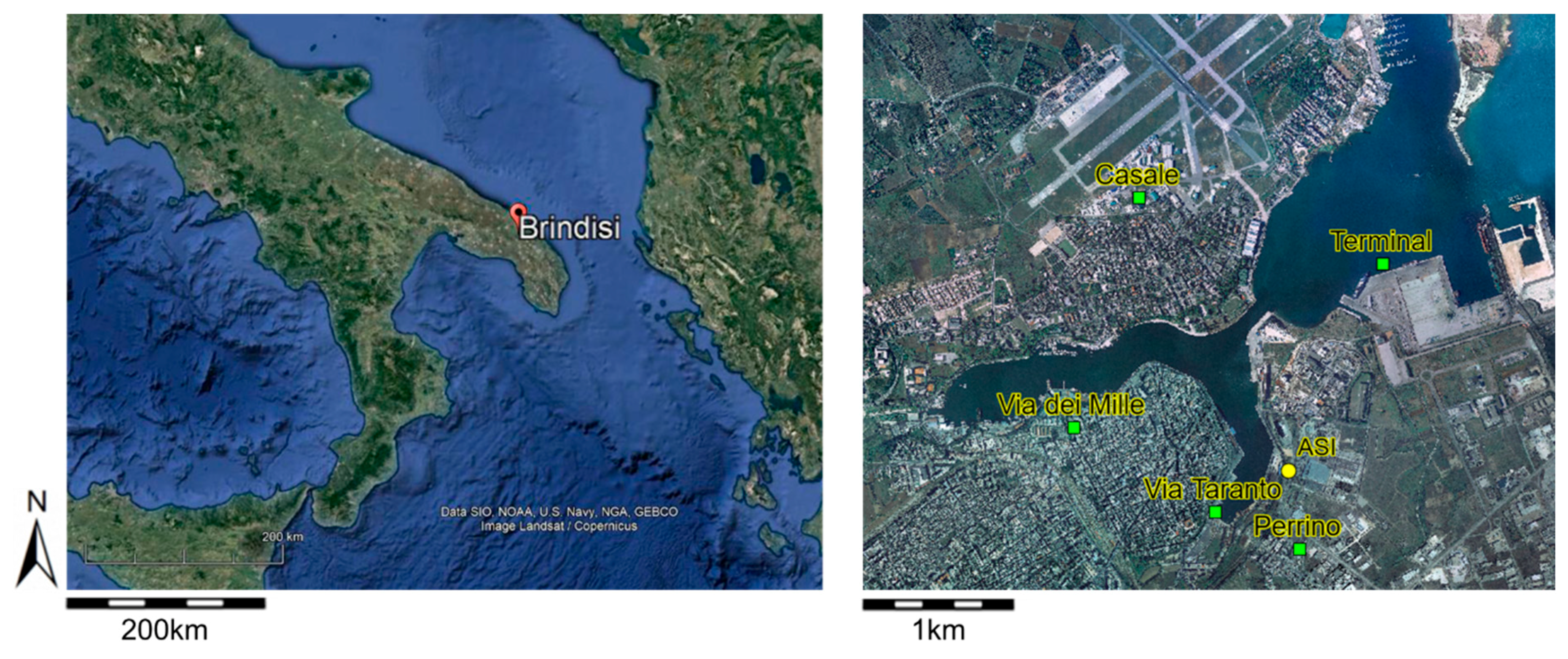
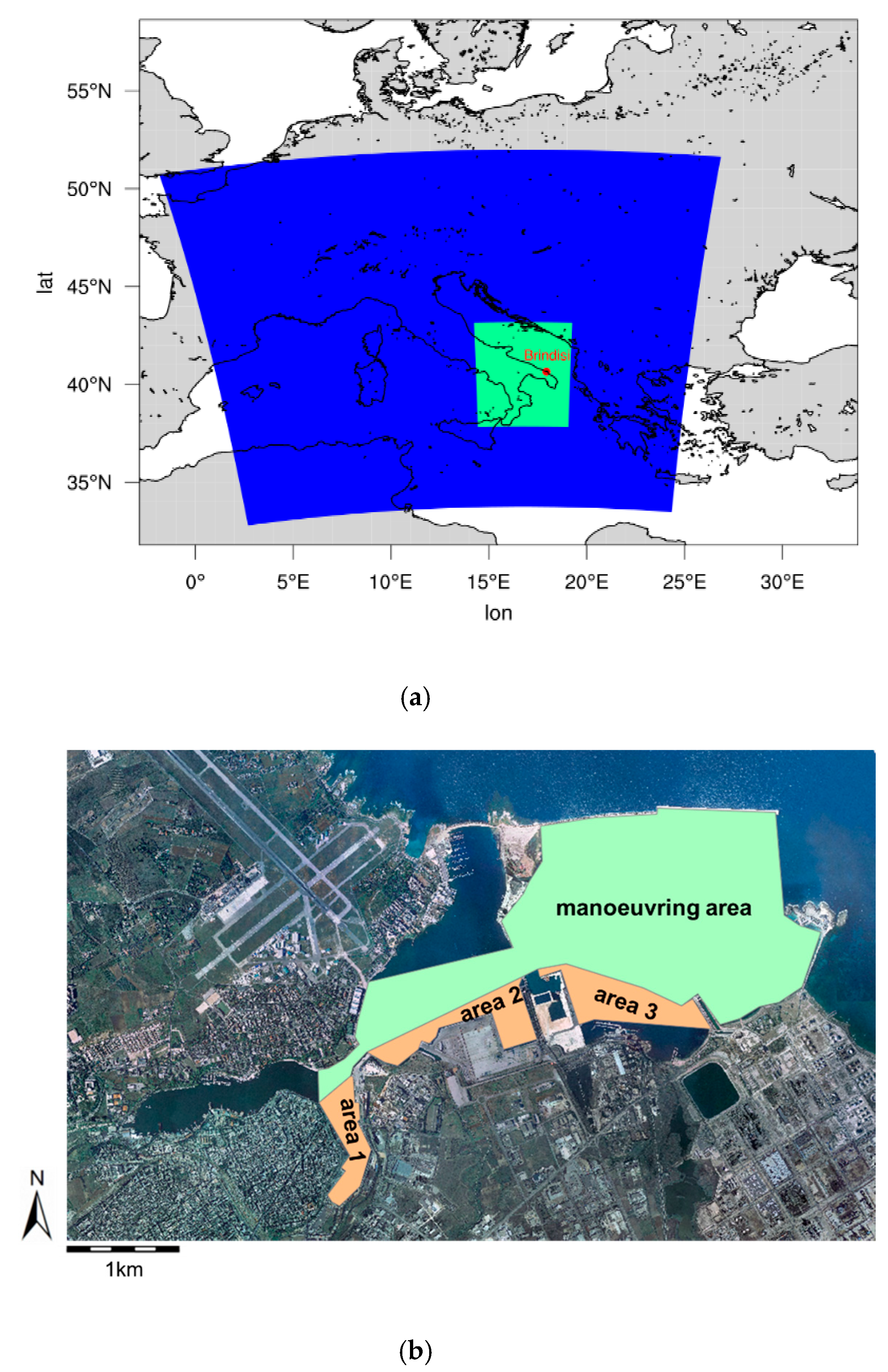
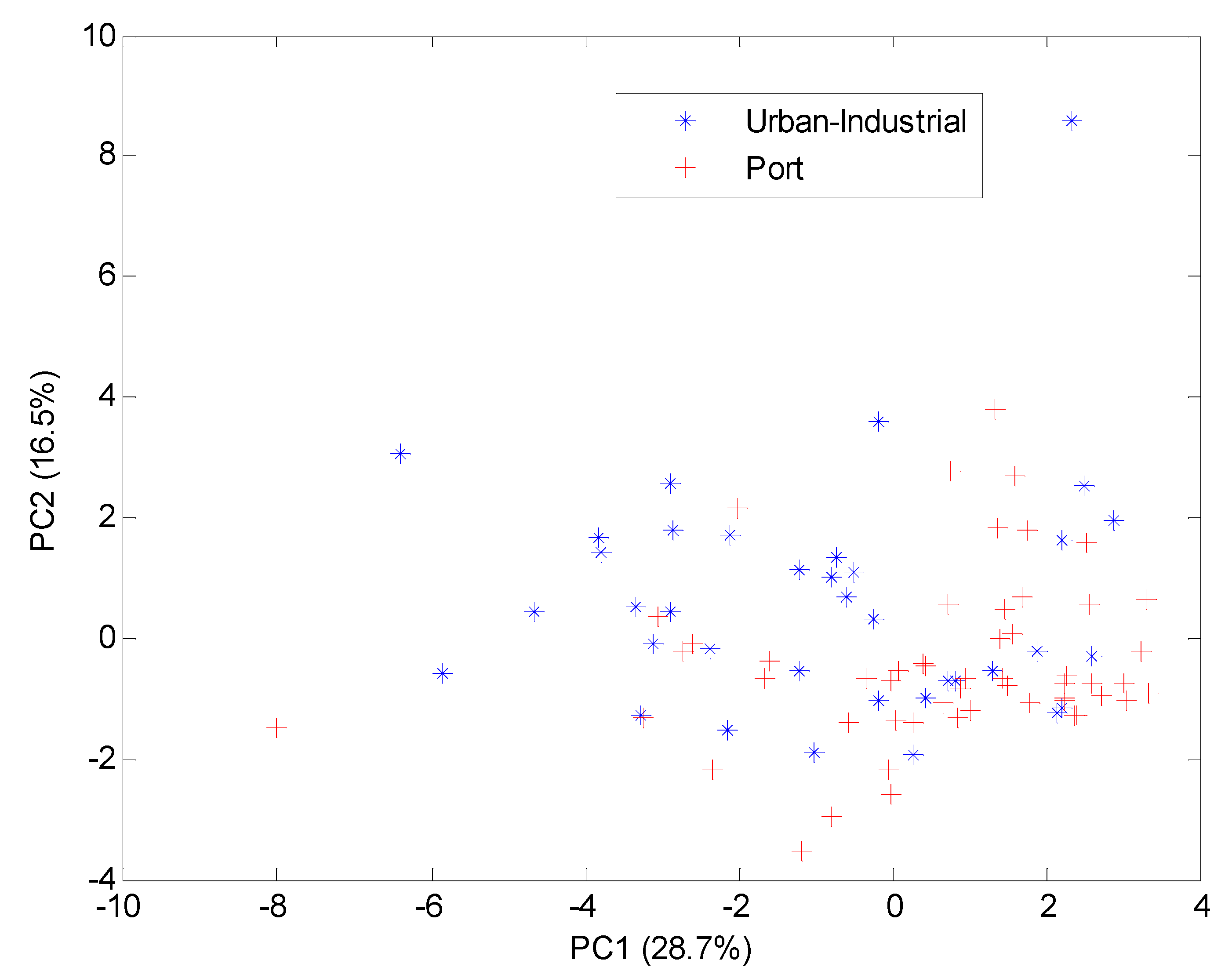
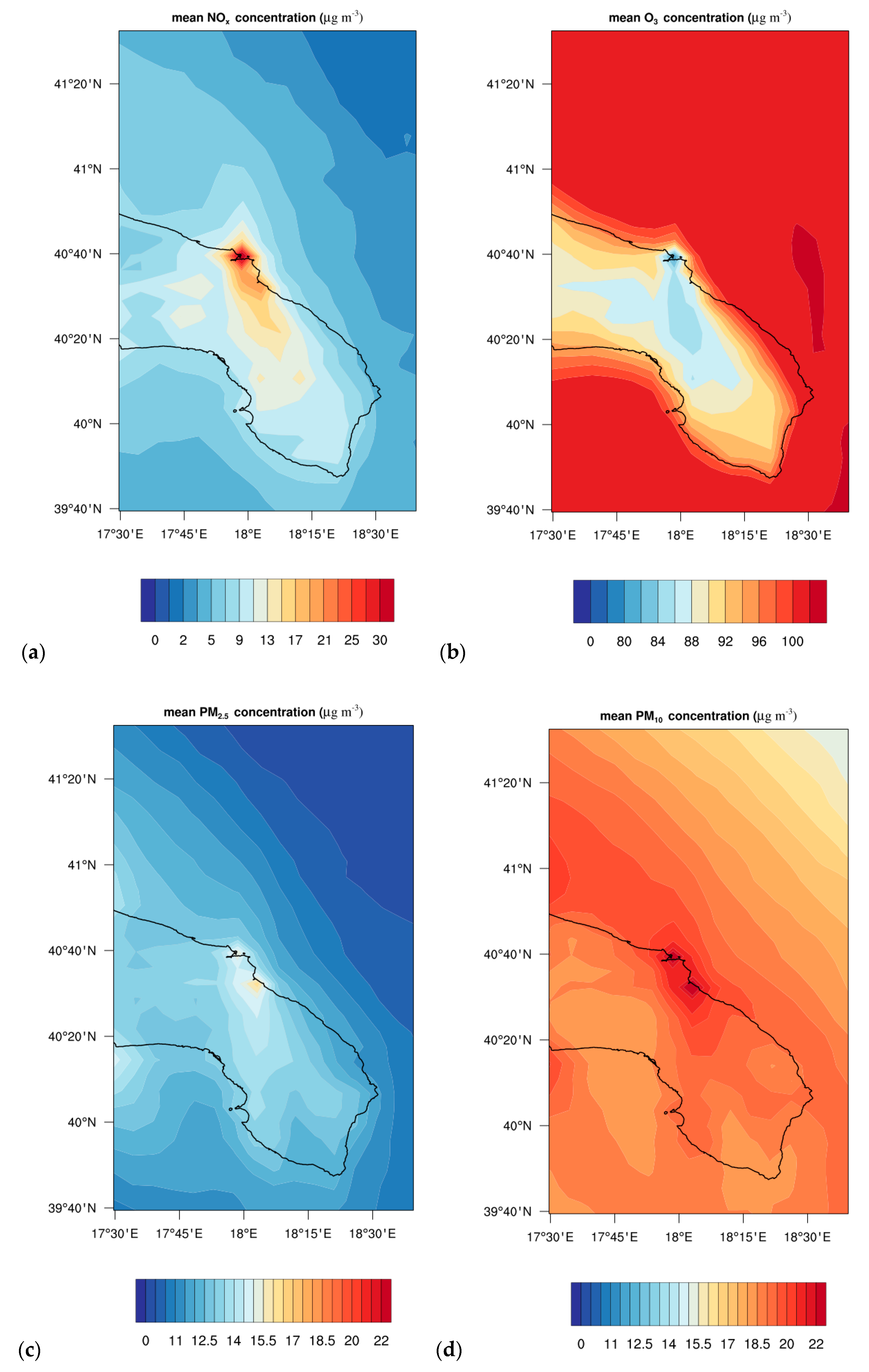
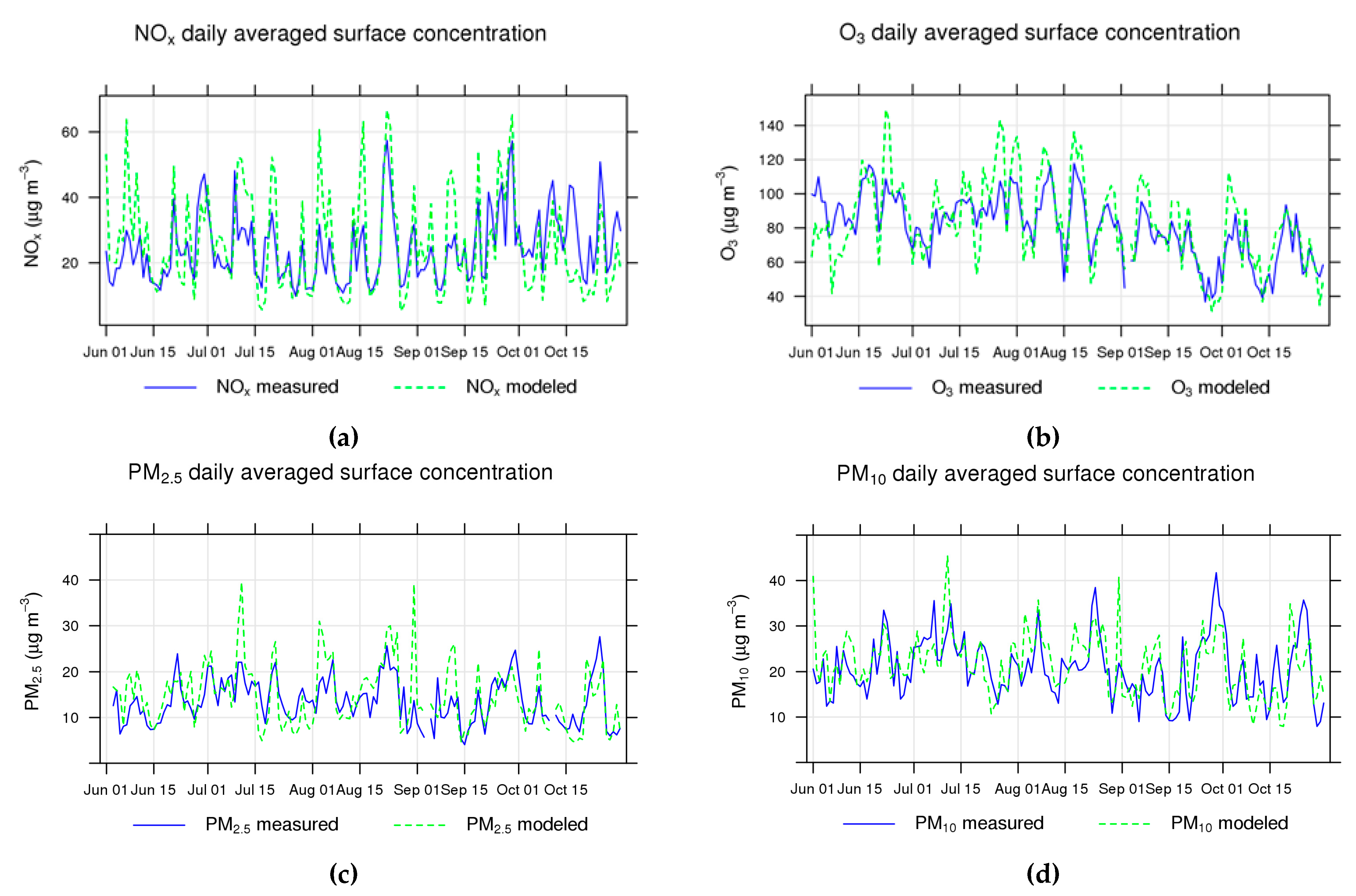
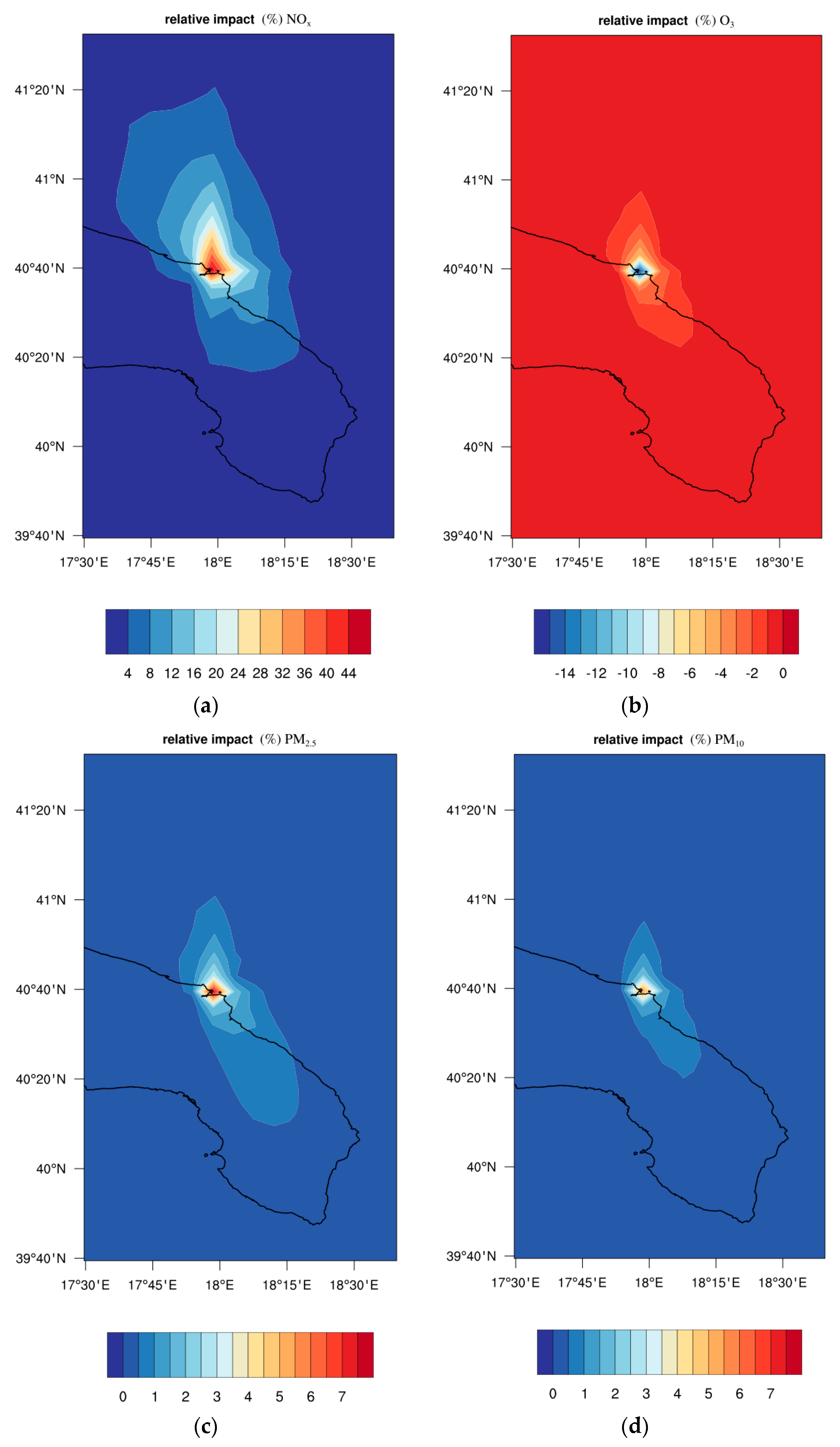
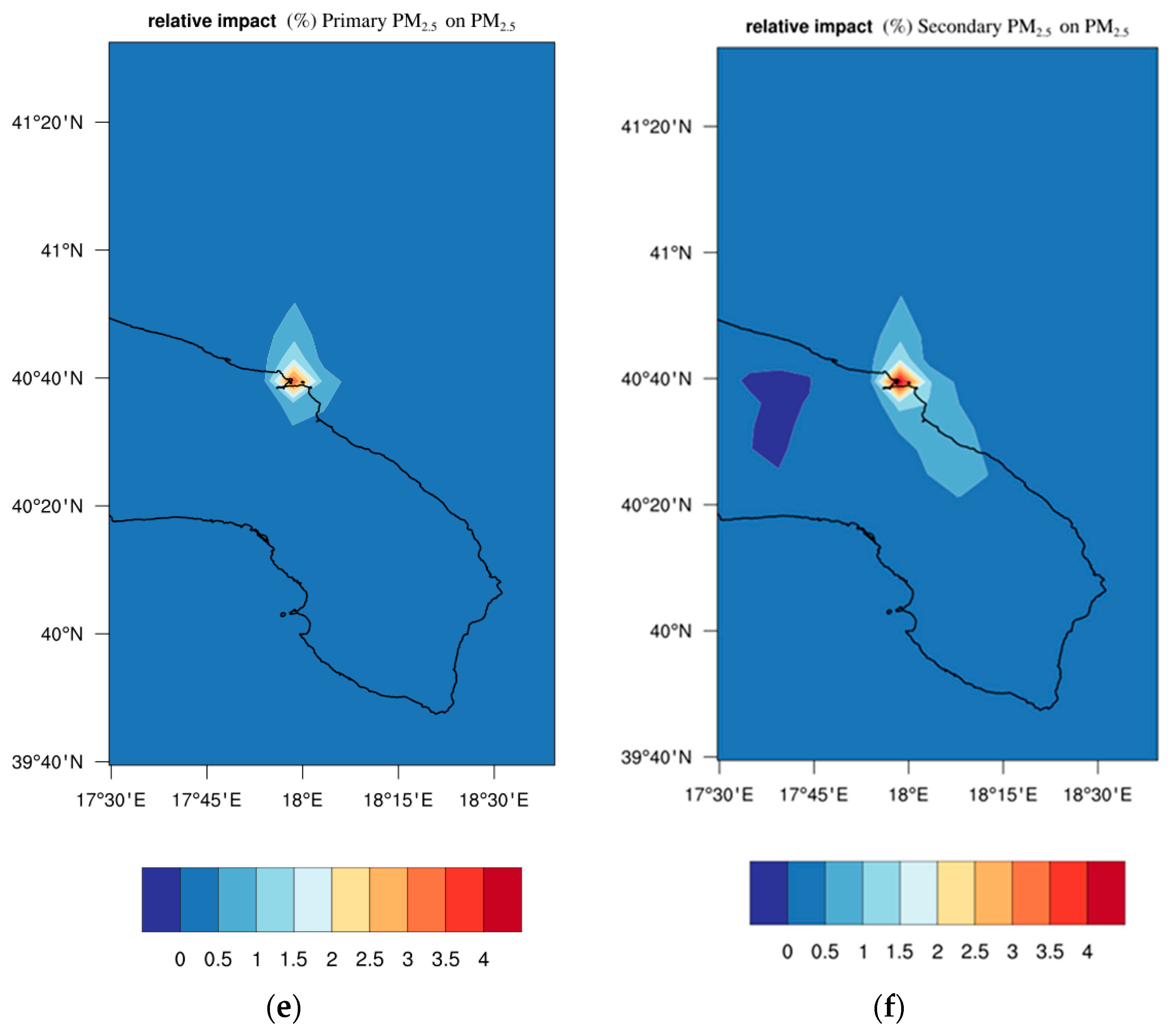
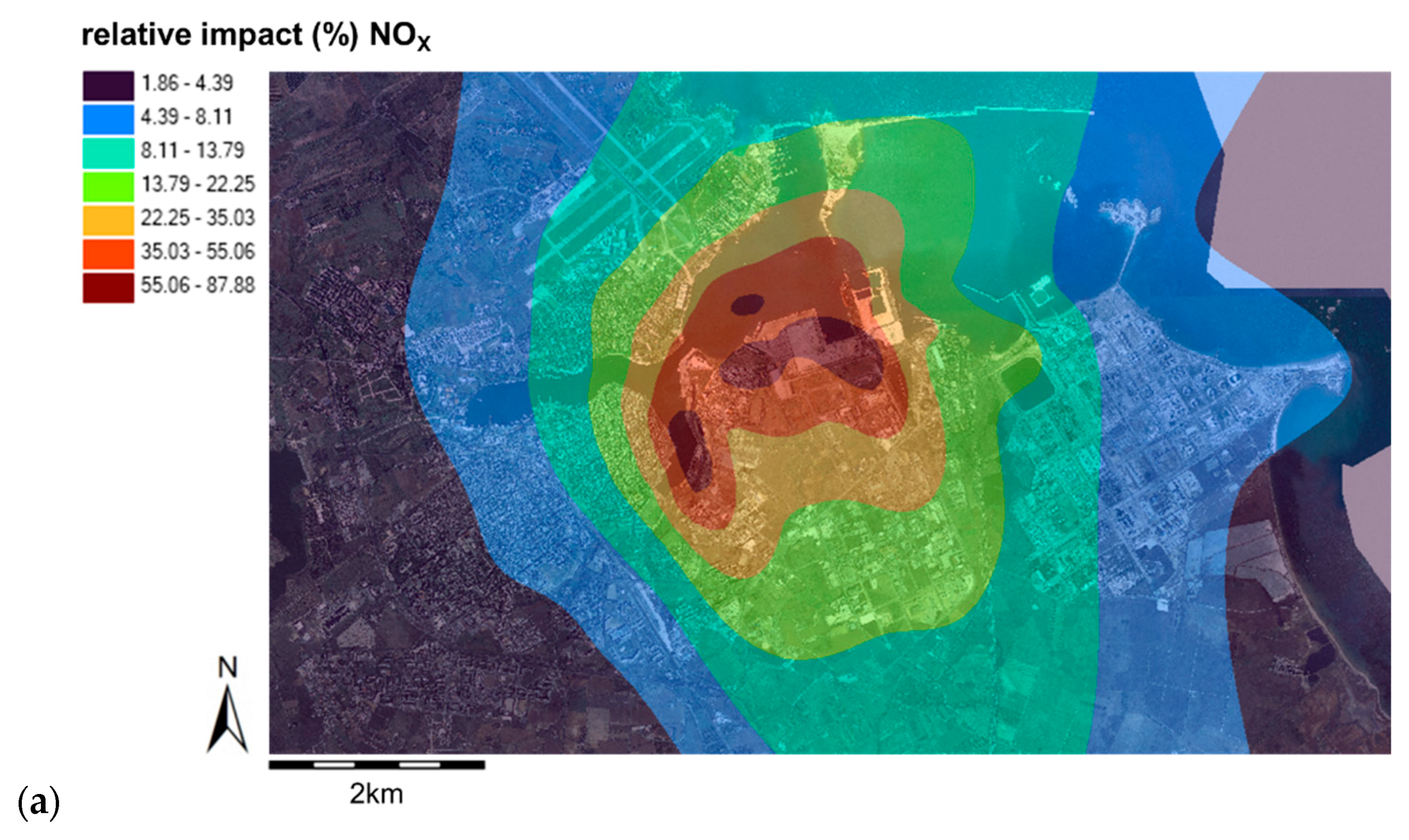
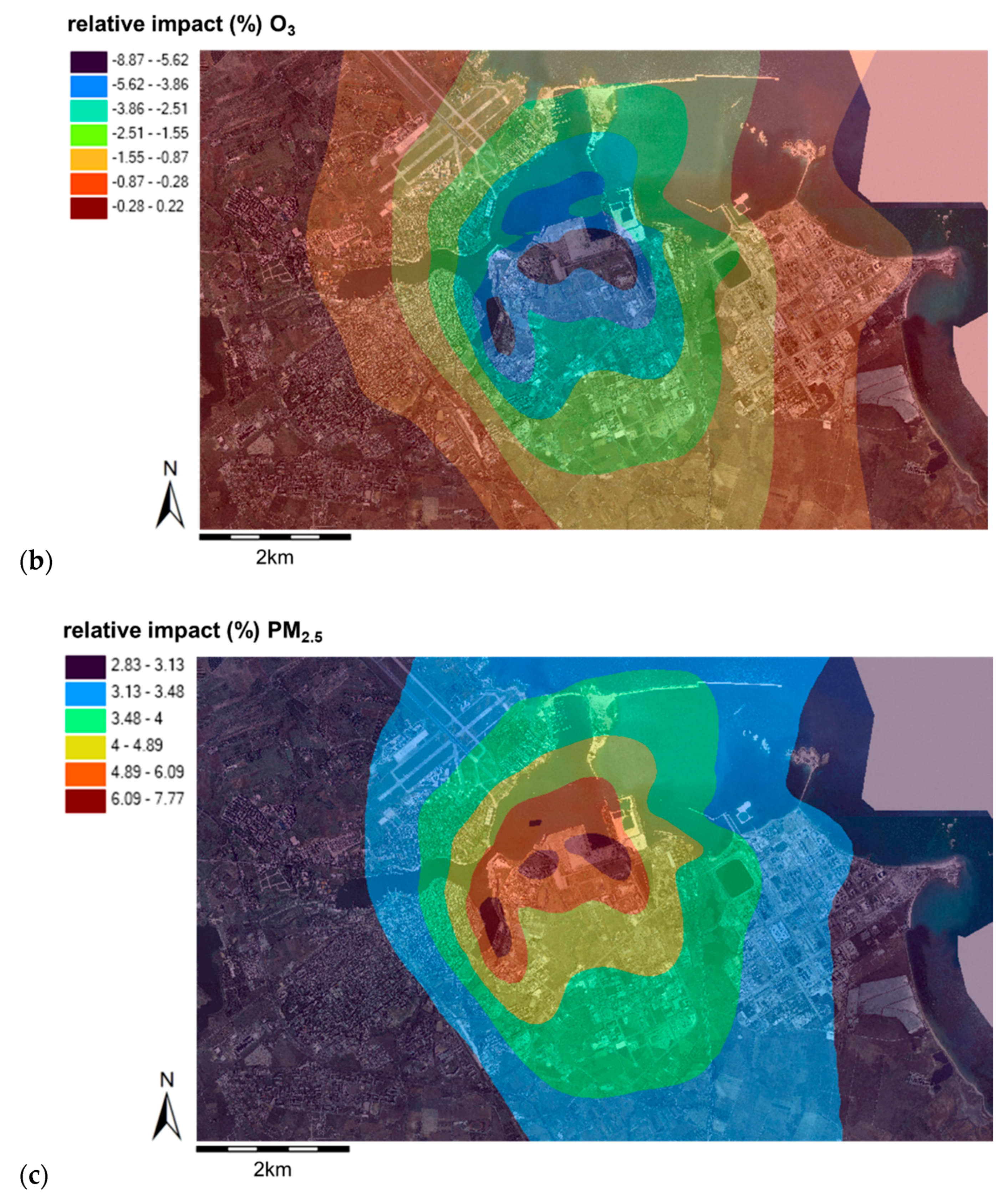
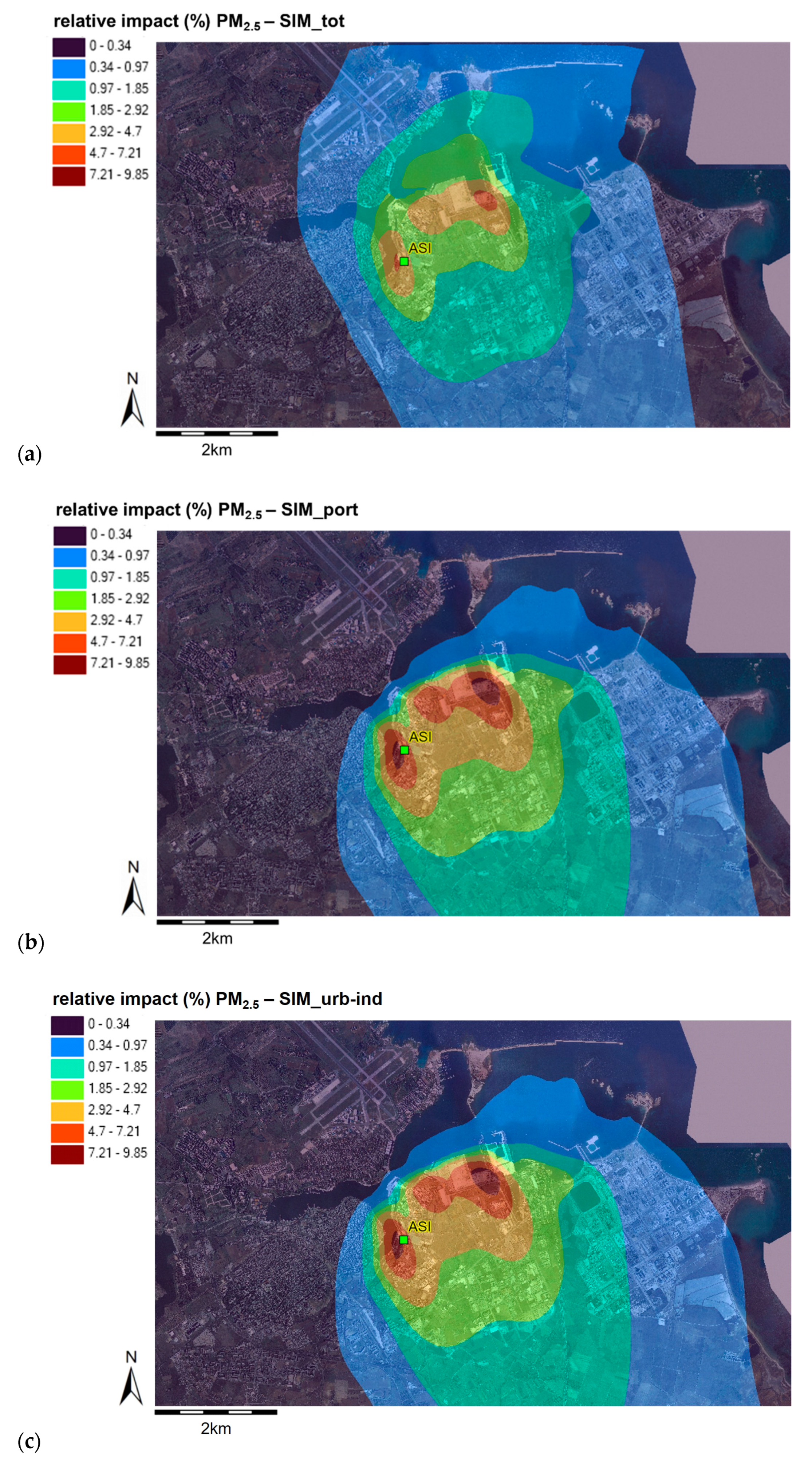
| Urban-Industrial | Port | |||||
|---|---|---|---|---|---|---|
| (ng m−3) | Median | Max | Min | Median | Max | Min |
| Al | 302 | 1221 | 14 | 242 | 1104 | 11 |
| Zn | 13 | 90 | 0.12 | 13 | 129 | 0.14 |
| Fe | 96 | 358 | 2.5 | 58 | 417 | 0.03 |
| K | 340 | 1728 | 21 | 144 | 1246 | 29 |
| Na | 387 | 2584 | 50 | 316 | 1620 | 51 |
| Ca | 322 | 1268 | 19 | 302 | 1805 | 19 |
| Ti | 20 | 78 | 4.3 | 21 | 46 | 3.6 |
| Mg | 102 | 744 | 30 | 85 | 852 | 21 |
| V | 2.6 | 7.5 | 0.7 | 3.0 | 27 | 0.32 |
| Ni | 2.9 | 20 | 0.02 | 1.7 | 11 | 0.14 |
| Cu | 3.2 | 22 | 1.3 | 1.7 | 13 | 0.19 |
| Pb | 4.2 | 16 | 1.5 | 3.1 | 43 | 1 |
| Cr | 0.8 | 10 | 0.02 | 0.36 | 2.1 | 0.02 |
| Cd | 0.07 | 0.24 | 0.02 | 0.06 | 0.20 | 0.02 |
| Mn | 2.7 | 7.0 | 0.21 | 1.8 | 7.5 | 0.04 |
| Sb | 1.4 | 30 | 0.12 | 0.7 | 26 | 0.10 |
| Cl− | 36 | 1021 | 0.48 | 26 | 410 | 1.7 |
| NO3− | 243 | 1150 | 29 | 170 | 1942 | 29 |
| SO42− | 2868 | 7876 | 859 | 2999 | 7373 | 835 |
| C2O42− | 121 | 244 | 32 | 130 | 304 | 41 |
| Na+ | 251 | 837 | 36 | 221 | 472 | 52 |
| NH4+ | 987 | 2272 | 256 | 1072 | 3879 | 177 |
| K+ | 219 | 1663 | 39 | 125 | 1018 | 19 |
| Mg2+ | 45 | 120 | 5.5 | 33 | 105 | 6.1 |
| Ca2+ | 231 | 730 | 59 | 144 | 1375 | 31 |
| WSOC | 1480 | 5713 | 243 | 1276 | 2745 | 243 |
| WSIC | 46 | 249 | 27 | 27 | 854 | 27 |
| OC | 2977 | 6960 | 509 | 1751 | 5977 | 395 |
| EC | 521 | 1371 | 195 | 384 | 1173 | 0.15 |
| TC | 4300 | 8785 | 1588 | 2816 | 7557 | 462 |
| PM2.5 (µg m−3) | 17 | 28 | 6.0 | 14 | 27 | 4.9 |
| PC1 | PC2 | PC3 | PC4 | PC5 | PC6 | PC7 | |
|---|---|---|---|---|---|---|---|
| Fe | 0.47 | 0.03 | −0.11 | 0.08 | 0.01 | −0.01 | 0.06 |
| V | 0.43 | 0.02 | 0.21 | 0.01 | −0.15 | −0.09 | −0.02 |
| Ni | 0.38 | −0.09 | 0.04 | 0.06 | 0.10 | 0.00 | −0.32 |
| Cu | 0.10 | −0.10 | −0.03 | 0.62 | 0.08 | 0.02 | −0.15 |
| Pb | −0.06 | −0.08 | −0.01 | −0.20 | 0.06 | 0.03 | 0.71 |
| Cd | 0.11 | 0.02 | 0.12 | 0.17 | 0.03 | −0.02 | 0.44 |
| Mn | 0.44 | 0.04 | −0.01 | −0.08 | 0.06 | 0.06 | 0.06 |
| OC | 0.17 | −0.06 | −0.07 | 0.04 | 0.41 | 0.10 | 0.09 |
| EC | 0.21 | −0.07 | −0.16 | 0.38 | 0.02 | −0.03 | 0.33 |
| Cl− | −0.14 | 0.51 | −0.10 | 0.19 | 0.02 | −0.04 | 0.03 |
| NO3− | −0.24 | 0.20 | 0.14 | 0.55 | −0.13 | 0.02 | 0.11 |
| SO4− | 0.04 | 0.02 | 0.64 | −0.06 | 0.06 | 0.00 | 0.02 |
| Na+ | 0.07 | 0.65 | 0.00 | −0.09 | 0.04 | −0.10 | −0.04 |
| NH4+ | −0.04 | −0.06 | 0.66 | 0.07 | −0.03 | 0.01 | 0.03 |
| K+ | 0.03 | 0.16 | 0.04 | −0.12 | 0.54 | −0.07 | 0.09 |
| Mg2+ | 0.16 | 0.46 | 0.07 | −0.09 | −0.04 | 0.25 | −0.04 |
| Ca2+ | 0.03 | 0.04 | −0.01 | 0.01 | 0.09 | 0.62 | 0.04 |
| WSOC | −0.20 | −0.07 | 0.07 | 0.11 | 0.68 | −0.01 | −0.16 |
| WSIC | −0.06 | −0.05 | 0.00 | 0.01 | −0.08 | 0.71 | −0.04 |
| Explained Variance (%) | 28.7 | 16.5 | 10.3 | 8.3 | 6.9 | 5.3 | 4.9 |
| Urban-Industrial | Port | Correct Prediction (%) | |
|---|---|---|---|
| Urban-Industrial | 20 | 13 | 61 |
| Port | 10 | 48 | 83 |
| µg m−3 | PM2.5 | SIA | SOA | Combustion | Crustal Matter | Anthropogenic Metals | Sea Salt | Undef. |
|---|---|---|---|---|---|---|---|---|
| Urban-Industrial | 17 ± 6 | 6.2 ± 1.6 | 3.1 ± 1.2 | 3.3 ± 0.2 | 3 ± 2 | 0.040 ± 0.019 | 0.6 ± 0.2 | 0.3 ± 0.4 |
| Port | 14 ± 5 | 5.5 ± 1.6 | 2.4 ± 0.9 | 2.4 ± 0.2 | 3 ± 2 | 0.031 ± 0.025 | 0.5 ± 0.2 | 0.2 ± 0.3 |
| Modelled (µg m−3) | Measured (µg m−3) | MB (µg m−3) | RMSE (µg m−3) | R | |
|---|---|---|---|---|---|
| NOX | 25.61 | 24.68 | 0.93 | 11.17 | 0.68 |
| O3 | 83.54 | 79.71 | 3.83 | 16.19 | 0.78 |
| PM2.5 | 14.91 | 13.59 | 1.32 | 5.69 | 0.64 |
| PM10 | 21.53 | 20.85 | 0.68 | 5.97 | 0.61 |
| BOLCHEM | % Impact |
|---|---|
| NOX | 37.6 |
| O3 | −11.7 |
| Primary PM2.5 | 2.7 |
| Secondary PM2.5 | 3.4 |
| PM2.5 | 6.1 |
| PM10 | 4.3 |
| Modelled PM2.5 (µg m−3) | Measured PM2.5 (µg m−3) | Modelled Impact (%) | |
|---|---|---|---|
| SIM_tot | 14.0 | 16 ± 6 | 4.2 |
| SIM_port | 12.9 | 14 ± 5 | 6.8 |
| SIM_urb-ind | 16.8 | 17 ± 6 | 0.9 |
Publisher’s Note: MDPI stays neutral with regard to jurisdictional claims in published maps and institutional affiliations. |
© 2021 by the authors. Licensee MDPI, Basel, Switzerland. This article is an open access article distributed under the terms and conditions of the Creative Commons Attribution (CC BY) license (http://creativecommons.org/licenses/by/4.0/).
Share and Cite
Cesari, R.; Genga, A.; Buccolieri, R.; Di Sabatino, S.; Siciliano, M.; Siciliano, T.; Dinoi, A.; Maurizi, A.; Ielpo, P. Combining Chemical Composition Data and Numerical Modelling for the Assessment of Air Quality in a Mediterranean Port City. Appl. Sci. 2021, 11, 2181. https://doi.org/10.3390/app11052181
Cesari R, Genga A, Buccolieri R, Di Sabatino S, Siciliano M, Siciliano T, Dinoi A, Maurizi A, Ielpo P. Combining Chemical Composition Data and Numerical Modelling for the Assessment of Air Quality in a Mediterranean Port City. Applied Sciences. 2021; 11(5):2181. https://doi.org/10.3390/app11052181
Chicago/Turabian StyleCesari, Rita, Alessandra Genga, Riccardo Buccolieri, Silvana Di Sabatino, Maria Siciliano, Tiziana Siciliano, Adelaide Dinoi, Alberto Maurizi, and Pierina Ielpo. 2021. "Combining Chemical Composition Data and Numerical Modelling for the Assessment of Air Quality in a Mediterranean Port City" Applied Sciences 11, no. 5: 2181. https://doi.org/10.3390/app11052181
APA StyleCesari, R., Genga, A., Buccolieri, R., Di Sabatino, S., Siciliano, M., Siciliano, T., Dinoi, A., Maurizi, A., & Ielpo, P. (2021). Combining Chemical Composition Data and Numerical Modelling for the Assessment of Air Quality in a Mediterranean Port City. Applied Sciences, 11(5), 2181. https://doi.org/10.3390/app11052181








